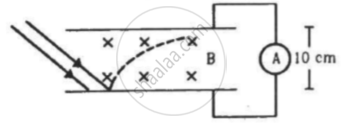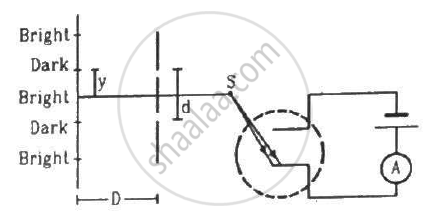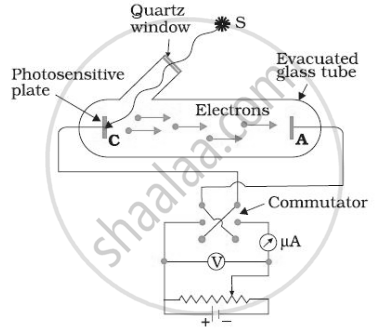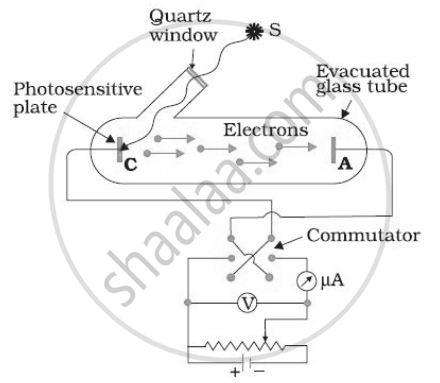Advertisements
Advertisements
Question
In an experiment on photoelectric effect, the emitter and the collector plates are placed at a separation of 10 cm and are connected through an ammeter without any cell. A magnetic field B exists parallel to the plates. The work function of the emitter is 2.39 eV and the light incident on it has wavelengths between 400 nm and 600 nm. Find the minimum value of B for which the current registered by the ammeter is zero. Neglect any effect of space charge.

Solution
Given:
Separation between the collector and emitter, d = 10 cm
Work function, ϕ = 2.39 eV
Wavelength range, λ1 = 400 nm to λ2 = 600 nm
Magnetic field B will be minimum if energy is maximum.
For maximum energy, wavelength λ should be minimum.
Einstein's photoelectric equation :
`E = (hc)/lambda - phi`
Here , h = Planck's constant
`lambda` = Wavelength of light
c = speed of light
`therefore E = 1242/400 - 2.39`
= `3.105 - 2.39 = 0.715 "eV"`
The beam of ejected electrons will be bent by the magnetic field. If the electrons do not reach the other plates, there will be no current.
When a charged particle is sent perpendicular to a magnetic field, it moves along a circle of radius,
`r = (mv)/(qB)`,
where m = mass of charge particle
B = magnetic field
v = velocity of particle
q = charge on the particle
Radius of the circle should be equal to r = d, so that no current flows in the Circuit .
⇒ `r = sqrt((2mE)/(qB))` `(∵ mv = sqrt(2mE))`
⇒ `0.1 = sqrt((2 xx 9.1 xx 10^-31 xx 1.6 xx 10^-19 xx 0.715)/(1.6 xx 10^-19 xx B))`
⇒ `B = sqrt((2 xx 9.1 xx 1.6 xx 0.715 xx 10^-50)/(1.6 xx 10^-20))`
⇒ `B = sqrt((2 xx 9.1 xx 1.6 xx 0.715)/(1.6)) xx 10^-5`
⇒ `B = 2.85 xx 10^-5 "T"`
APPEARS IN
RELATED QUESTIONS
The threshold frequency for a certain metal is 3.3 × 1014 Hz. If light of frequency 8.2 × 1014 Hz is incident on the metal, predict the cutoff voltage for the photoelectric emission.
Light of frequency 7.21 × 1014 Hz is incident on a metal surface. Electrons with a maximum speed of 6.0 × 105 m/s are ejected from the surface. What is the threshold frequency for photoemission of electrons?
Is the formula you employ in (a) valid for calculating radius of the path of a 20 MeV electron beam? If not, in what way is it modified?
What is so special about the combination e/m? Why do we not simply talk of e and m separately?
Define the term "cut off frequency" in photoelectric emission. The threshod frequency of a metal is f. When the light of frequency 2f is incident on the metal plate, the maximum velocity of photo-electrons is v1. When the frequency of the incident radiation is increased to 5f, the maximum velocity of phto-electrons is v2. Find the ratio v1 : v2.
In an experiment on photoelectric effect, light of wavelength 400 nm is incident on a cesium plate at the rate of 5.0 W. The potential of the collector plate is made sufficiently positive with respect to the emitter, so that the current reaches its saturation value. Assuming that on average, one out of every 106 photons is able to eject a photoelectron, find the photocurrent in the circuit.
A horizontal cesium plate (φ = 1.9 eV) is moved vertically downward at a constant speed v in a room full of radiation of wavelength 250 nm and above. What should be the minimum value of v so that the vertically-upward component of velocity is non-positive for each photoelectron?
(Use h = 6.63 × 10-34J-s = 4.14 × 10-15 eV-s, c = 3 × 108 m/s and me = 9.1 × 10-31kg)
In the arrangement shown in the figure, y = 1.0 mm, d = 0.24 mm and D = 1.2 m. The work function of the material of the emitter is 2.2 eV. Find the stopping potential V needed to stop the photocurrent.

(Use h = 6.63 × 10-34J-s = 4.14 × 10-15 eV-s, c = 3 × 108 m/s and me = 9.1 × 10-31kg)
Plot a graph to show the variation of stopping potential with frequency of incident radiation in relation to photoelectric effect.
Work function of aluminium is 4.2 eV. If two photons each of energy 2.5 eV are incident on its surface, will the emission of electrons take place? Justify your answer.
In Photoelectric effect ______.
In the experimental set up for studying photoelectric effect, if keeping the frequency of the incident radiation and the accelerating potential fixed, the intensity of light is varied, then ______.

For a given frequency of light and a positive plate potential in the set up below, If the intensity of light is increased then ______.

In various experiments on photo electricity, the stopping potential for a given frequency of the incident radiation is ______.
When a beam of 10.6 eV photons of intensity 2.0 W/m2 falls on a platinum surface of area 1.0 × 10-4 m2, only 53% of the incident photons eject photoelectrons. The number of photoelectrons emitted per second is ______.
An increase in the intensity of the radiation causing photo-electric emission from a surface does not affect the maximum K.E. of the photoelectrons. Explain.
